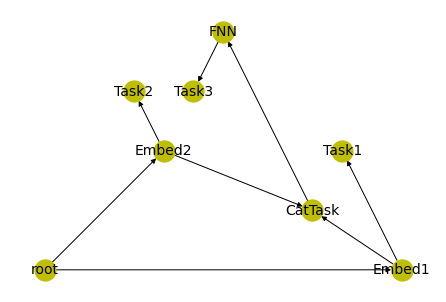torchMTL
A lightweight module for Multi-Task Learning in pytorch.
torchmtl tries to help you composing modular multi-task architectures with minimal effort. All you need is a list of dictionaries in which you define your layers and how they build on each other. From this, torchmtl constructs a meta-computation graph which is executed in each forward pass of the created MTLModel. To combine outputs from multiple layers, simple wrapper functions are provided.
Installation
torchmtl can be installed via pip:
pip install torchmtl
Quickstart (or find examples here)
Assume you want to train a network on three tasks as shown below.

To construct such an architecture with torchmtl, you simply have to define the following list
tasks = [
{
'name': "Embed1",
'layers': Sequential(*[Linear(16, 32), Linear(32, 8)]),
# No anchor_layer means this layer receives input directly
},
{
'name': "Embed2",
'layers': Sequential(*[Linear(16, 32), Linear(32, 8)]),
# No anchor_layer means this layer receives input directly
},
{
'name': "CatTask",
'layers': Concat(dim=1),
'loss_weight': 1.0,
'anchor_layer': ['Embed1', 'Embed2']
},
{
'name': "Task1",
'layers': Sequential(*[Linear(8, 32), Linear(32, 1)]),
'loss': MSELoss(),
'loss_weight': 1.0,
'anchor_layer': 'Embed1'
},
{
'name': "Task2",
'layers': Sequential(*[Linear(8, 64), Linear(64, 1)]),
'loss': BCEWithLogitsLoss(),
'loss_weight': 1.0,
'anchor_layer': 'Embed2'
},
{
'name': "FNN",
'layers': Sequential(*[Linear(16, 32), Linear(32, 32)]),
'anchor_layer': 'CatTask'
},
{
'name': "Task3",
'layers': Sequential(*[Linear(32, 16), Linear(16, 1)]),
'anchor_layer': 'FNN',
'loss': MSELoss(),
'loss_weight': 'auto',
'loss_init_val': 1.0
}
]
You can build your final model with the following lines in which you specify from which layers you would like to receive the output.
from torchmtl import MTLModel
model = MTLModel(tasks, output_tasks=['Task1', 'Task2', 'Task3'])
This constructs a meta-computation graph which is executed in each forward pass of your model. You can verify whether the graph was properly built by plotting it using the networkx library:
import networkx as nx
pos = nx.planar_layout(model.g)
nx.draw(model.g, pos, font_size=14, node_color="y", node_size=450, with_labels=True)

The training loop
You can now enter the typical pytorch training loop and you will have access to everything you need to update your model:
for X, y in data_loader:
optimizer.zero_grad()
# Our model will return a list of predictions (from the layers specified in `output_tasks`),
# loss functions, and regularization parameters (as defined in the tasks variable)
y_hat, l_funcs, l_weights = model(X)
loss = 0
# We can now iterate over the tasks and accumulate the losses
for i in range(len(y_hat)):
loss += l_weights[i] * l_funcs[i](y_hat[i], y[i])
loss.backward()
optimizer.step()
Details on the layer definition
There are 6 keys that can be specified (name and layers must always be present):
layers
Basically takes any nn.Module that you can think of. You can plug in a transformer or just a handful of fully connected layers.
anchor_layer
This defines from which other layer this layer receives its input. Take care that the respective dimensions match.
loss
The loss function you want to compute on the output of this layer (l_funcs). Can be set to None or omitted altogether when only access to the layer's output is needed.
loss_weight
The scalar with which you want to regularize the respective loss (l_weights). If set to 'auto', a nn.Parameter is returned which will be updated through backpropagation. Can be set to None or omitted altogether when only access to the layer's output is needed.
loss_init_val
Only needed if loss_weight: 'auto'. The initialization value of the loss_weight parameter.
Wrapping functions
Nodes of the meta-computation graph don't have to be pytorch Modules. They can be concatenation functions or indexing functions that return a certain element of the input. If your X consists of two types of input data X=[X_1, X_2], you can use the SimpleSelect layer to select the X_1 by setting
from torchmtl.wrapping_layers import SimpleSelect
{ ...,
'layers' = SimpleSelect(selection_axis=0),
...
}
It should be trivial to write your own wrapping layers, but I try to provide useful ones with this library. If you have any layers in mind but no time to implement them, feel free to open an issue.
Logo credits and license: I reused and remixed (moved the dot and rotated the resulting logo a couple times) the pytorch logo from here (accessed through wikimedia commons) which can be used under the Attribution-ShareAlike 4.0 International license. Hence, this logo falls under the same license.



